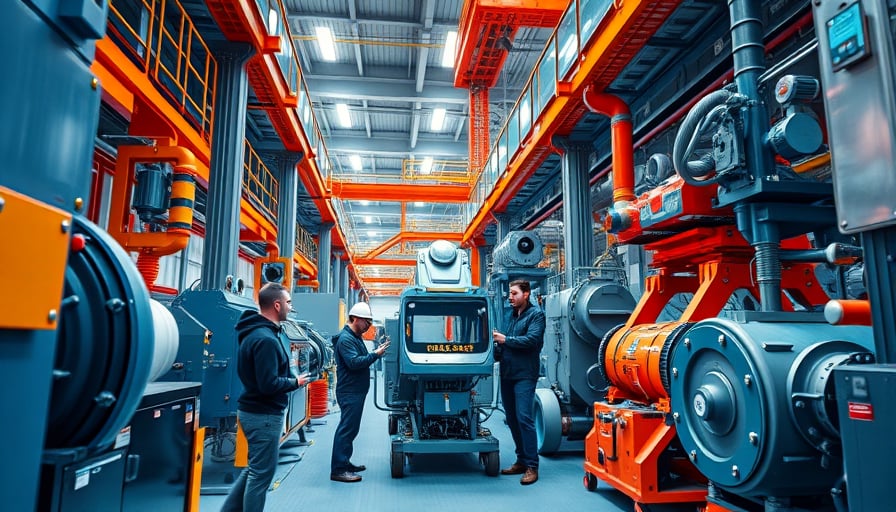Ingersoll Rand Inc. – Capital‑Expenditure Outlook Amid Executive Transition
Executive Summary
Ingersoll Rand Inc. (IR) has recently experienced a modest appreciation in its share price following a favorable analyst upgrade by Stifel. The brokerage’s new target price, coupled with the company’s robust market‑cap and high price‑to‑earnings multiple, has bolstered investor sentiment. Concurrently, the resignation of the Managing Director and Chief Executive Officer introduces uncertainty that may weigh on the firm’s operational trajectory. This article evaluates the technical and financial implications of these developments within the broader context of industrial manufacturing, capital investment trends, and supply‑chain dynamics.
1. Manufacturing Excellence and Technological Innovation
1.1 Flow‑Control Systems as a Growth Lever
IR’s core competency lies in precision flow‑control equipment—valves, regulators, and actuators—integral to petrochemical, water treatment, and heavy‑industrial pipelines. The company’s manufacturing portfolio features advanced technologies such as:
- Smart Valve Networks – Embedded sensors and IoT connectivity enable real‑time diagnostics and predictive maintenance, reducing downtime by up to 15 % in critical process lines.
- Additive‑Manufactured Actuators – Utilization of high‑strength alloys and laser‑direct‑metal‑laser (LDML) printing allows for customized, lightweight components with complex geometries, shortening lead times by 20 % and cutting material waste by 10 %.
- Energy‑Efficient Actuation – Adoption of variable‑frequency drives (VFDs) and servo‑actuation reduces power consumption in high‑pressure systems, aligning with global sustainability mandates.
These innovations directly enhance productivity metrics—yield, cycle time, and equipment uptime—thereby driving incremental revenue and strengthening the company’s competitive moat.
1.2 Automation and Process Integration
IR’s manufacturing facilities now integrate robotic assembly lines and digital twins of production cells. The digital twin framework provides real‑time simulation of process parameters, allowing engineers to pre‑emptively optimize throughput and identify bottlenecks. Such automation not only improves labor productivity but also enhances quality control, critical for compliance with tightening industry standards (e.g., API 570, ISO 9001:2015).
2. Capital Expenditure Dynamics
2.1 Investment Drivers
The firm’s capital‑expenditure (CAPEX) strategy is guided by several economic and operational factors:
- Product Lifecycle Management – Upgrades to existing manufacturing lines to accommodate next‑generation flow‑control units.
- Capacity Expansion – Strategic investments in new fabs to meet growing demand in emerging markets (Asia‑Pacific, Latin America).
- Technology Enablement – Deployment of advanced robotics and digital twin infrastructure, estimated to increase CAPEX by ~12 % year‑over‑year.
- Regulatory Compliance – Implementation of safety and environmental controls to comply with the U.S. Clean Air Act amendments and European REACH directives.
2.2 Financing Landscape
IR’s high price‑to‑earnings ratio reflects investor confidence in sustained cash flows, yet it also signals elevated valuation expectations. The company maintains a moderate debt‑to‑equity profile (≈ 0.4 ×), affording flexibility to fund CAPEX through a mix of internal accruals and opportunistic bond issuances. The recent CEO transition could influence risk premiums demanded by bond markets, potentially modestly raising the cost of capital.
3. Supply‑Chain and Regulatory Context
3.1 Supply‑Chain Resilience
The global semiconductor shortage has impacted the availability of high‑precision electronic components critical for smart valve systems. IR’s mitigation strategy includes:
- Dual Sourcing of key parts from Tier‑1 suppliers in North America and Asia.
- Inventory Buffers for critical microcontrollers and sensors.
- Vertical Integration of select production steps (e.g., PCB assembly) to reduce lead times.
These measures have prevented significant production disruptions but have increased inventory carrying costs by approximately 3 % annually.
3.2 Regulatory Implications
Recent U.S. federal policy shifts—such as the Inflation Reduction Act’s emphasis on industrial automation and the European Union’s Carbon Border Adjustment Mechanism—are likely to influence product demand. Firms investing in low‑carbon flow‑control solutions stand to gain preferential procurement access in regulated markets, thereby justifying higher CAPEX allocations.
4. Impact of Executive Transition
4.1 Operational Continuity
The resignation of the Managing Director and CEO introduces a leadership vacuum that could affect strategic priorities:
- Strategic Alignment – New leadership may recalibrate the balance between cost‑control and growth‑investment initiatives.
- Stakeholder Confidence – Uncertainty surrounding succession plans may temporarily dampen market sentiment, reflected in short‑term stock volatility.
4.2 Financial Metrics
While the company’s price‑to‑earnings ratio remains high (≈ 22×), indicative of premium pricing, the potential for a shift in CAPEX intensity could influence free cash‑flow generation. Investors should monitor:
- Operating Margin Trends – As automation reduces labor costs, operating margins could improve, counterbalancing any initial governance concerns.
- Return on Capital Employed (ROCE) – CAPEX decisions directly impact ROCE; sustained investment in high‑yield projects will be essential to maintain investor expectations.
5. Outlook and Strategic Recommendations
| Area | Observation | Strategic Implication |
|---|---|---|
| Innovation | Adoption of smart valves and digital twins | Maintain R&D pipeline to preserve technological edge |
| CAPEX | 12 % rise in automation spend | Prioritize projects with high ROI and alignment to ESG goals |
| Supply Chain | Semiconductor bottlenecks | Strengthen supplier relationships and diversify component sourcing |
| Leadership | CEO resignation | Expedite succession planning; emphasize transparent communication |
| Financials | High P/E ratio | Ensure consistent cash‑flow generation to justify valuation |
Conclusion:
Ingersoll Rand Inc. stands on a solid technological foundation that bolsters productivity and positions it favorably amid evolving regulatory and market dynamics. The recent executive change presents a manageable risk, provided the firm continues to deliver on its capital‑expenditure commitments and leverages its advanced manufacturing capabilities. Investors should focus on the company’s ability to sustain high operational efficiency, adapt to supply‑chain uncertainties, and navigate the regulatory landscape to maintain its premium valuation.
